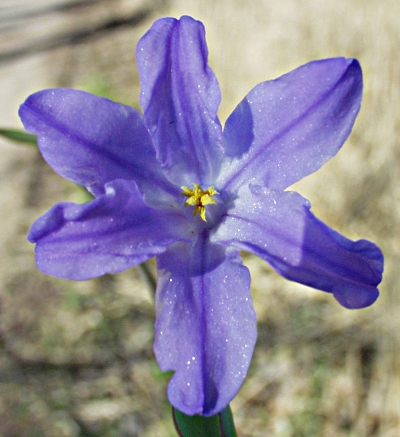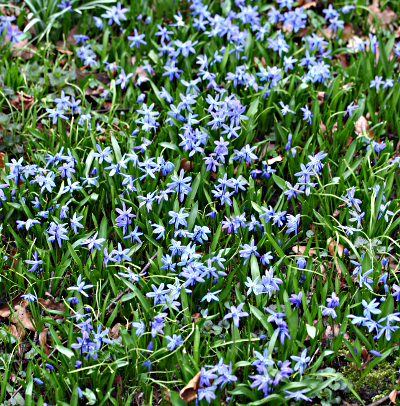Scilloideae |

Scilla, the squill, Scilla luciliae here, was the inspiration for the name of this subfamily

Flower carpet from Scilla siberica
Comprising up to 70 genera with about 900 species, the Scilloideae have the highest number of species in Eurasia and Africa. These are perennial herbs with underground or above-ground bulbs, sometimes with rhizomes. At least one basal leaf is formed, but usually several leaves form a basal rosette of mostly lance-shaped, rarely elliptic or roundish, parallel veined leaves with entire margins.
The non-leafed stalk bears a single flower or a racemous, spike-like or capitate inflorescence. The hermaphrodite flowers, which are usually bear a bract, are mostly actinomorphic and have 6 free petals or they are fused at the base. They are are not divided into calyx and corolla (perigonium). Sometimes, however, differ the inner 3 tepals from the outer 3 ones. The mostly 6 stamens are free or are fused with the petals. The usually superior ovary consists of 3 fused carpels. It bears a stylus with a sometimes trilobal scar.
After pollination by bees, bumblebees, moths or flies a dry fruit capsule is formed, that opens up with 3 valves and releases 3–30 spherical or broadly ovate, black seeds. Bluebells reproduce vegetative by forming daughter bulbs.
| Floral formula mostly: |
| * P(3+3) A3+3 G(3) superior
or * [P(3+3) A3+3] G(3) superior |
The Scilloideae be divided into 4 tribes: Hyacinthae, Ornithogaleae, OziroŽeae and Urgineeae, where the vast majority of genera will be found among the Hyacinthae. The other 3 tribes each contain only 1–2 genera.
Scilloideae are represented very numerous in the Cape flora (capensis). This smallest of the six floral kingdoms but most species-rich in relation to its size is located on the southern tip of Africa and includes about 70% plants that occur only there and nowhere else (endemics).
Interesting notes
Many plants of this subfamily belong to the geophytes. These are are characterized by underground storage organs such as bulbs, tubers or rhizomes and they already blooming in spring.
Drimia maritima, the sea squill, forms a football-sized bulb, whose central scales which are dried and ground were and are used as a drug against myocardial insufficiency.